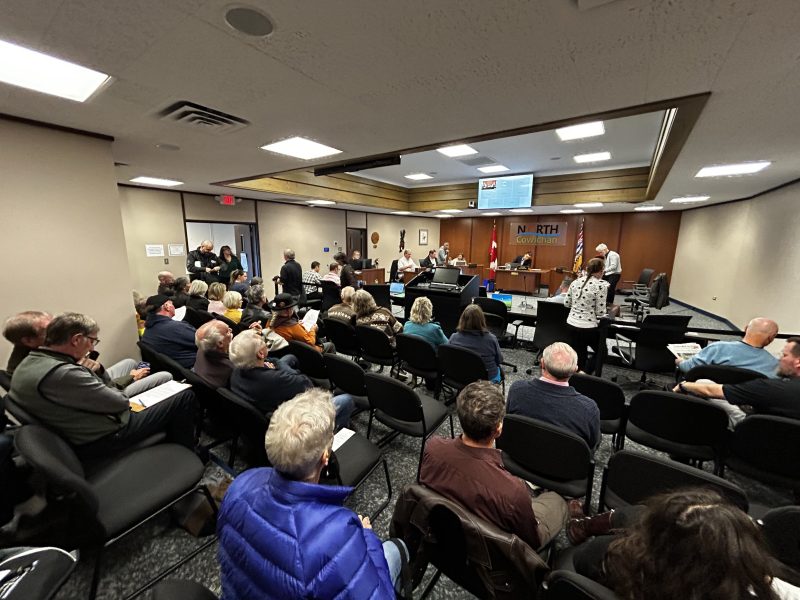
This article is from The Discourse’s Cowichan Valley newsletter. Sign up to get it in your inbox.
Editor’s note: This story contains some words and place names in Hul’qumi’num. There is a glossary at the end of the article.
What happened to the characters that make up Salish folklore? We live in a world filled with superheroes, villains and strong religious or historical figures. Names like Thor, Superman and Joan of Arc all conjure up an instant image and perhaps even a story, or concept, unique to the character.
Our modern world is filled with these characters, yet we know so little about the characters that played this part in the history and stories of the Salish people. We live in places with anglicized names like Cowichan, Chemainus and Nanaimo. Yet most of us know more about the gods of Mount Olympus in Greece than we know about the people who fell from the sky in Quw’utsun.
What if I told you that most erratics — large, out-of-place boulders — are connected to a story? Some may be from the battle between Xeel’s and Qise’q. Others may be left over from when Smaqw’uts threw them with his sling to vanquish the monster Sheshuq’um at Octopus Point. Hul’qumi’num place names hold keys that unlock some of these legends. And few tales are as notorious as the story of Chief “Tzouhalem.”
I use quotation marks because Tzouhalem is the anglicized version of the name Ts’uwxilum, which I will use henceforth. The story of Ts’uwxilum is fascinating because he exists as both a legendary character with supernatural powers and a legitimate figure of Western history, who attacked and traded with Fort Victoria. Ts’uwxilum gives us a rare chance to see his story from two lenses. The stories tell of his supernatural powers, of how he and Tsosieten led the tribes victory in the battle at Hwutl’upnets, and a hwunitum census from 1853 identifies him as the preeminent “chief.” So who was Ts’uwxilum?
It is said that when Ts’uwxilum was born there was a great storm and that thunder and lightning filled the sky. Ts’uwxilum’s father was appalled when he looked upon his disfigured son, for Ts’uwxilum’s head was too large and he had a hunched back. And if it weren’t for the pleas of his mother, Ts’uwxilum would have been “cast into the clam shell piles.”
When Ts’uwxilum was a young boy, his village at Kwa’mut’sun was raided while he and his grandmother were out picking berries. When they returned they found their village in the middle of a violent and terrifying raid by a northern tribe. They hid in the nearby bushes and watched the horror unfold. Ts’uwxilum watched as his younger brother and his mother were taken as slaves. They followed the raiders as they left the village and passed through the narrows. Ts’uwxilum watched on as the raiders threw his baby brother into the churning, boiling water of Sqtheq and released his mother, who threw herself into the water and drowned trying to save the baby.

From then Ts’uwxilum was raised by his grandmother, who taught him sacred Quw’utsun rituals to keep him strong in mind, body and spirit. The rituals gave Ts’uwxilum focus as he was not a popular child, due to his disfigurement, and this isolation led to his notorious bad temper.
Much like in the trials of Hercules, Ts’uwxilum was met by a host of supernatural beings, who challenged him and granted him amazing powers. He was met by a shne’um who granted him the ability to see in the dark. Another time Ts’uwxilum was met by a stl’eluqum who says it will be with Ts’uwxilum when he is in battle. In another tale he met a host of supernatural slhunlheni’ in an underwater cave who gave him “the power of a woman.” But they foreshadowed his downfall by saying, “if you go too far it will be a woman who kills you.” In one tale in particular it is said that Ts’uwxilum found the great rope that held Syalutsa’s canoe to the top of Swuq’us during the great flood. The rope in turn gave Ts’uwxilum the power to be stronger than his enemies and the power to become a great chief.
I have to stop here and make a very important note. What I’ve just told you is more like 10 stories. Each of these stories, when told by a master storyteller, would last no less than a day. In the interest of time, this is a bare-bones, Coles Notes version of the story. These details come from recorded accounts from Quw’utsun elders Abel Joe and Rosalie Seletze, as well as accounts compiled by the historian Chris Arnett. But we have to remember that storytelling is a great art form that was commonly practiced in yesteryear, and the character Ts’uwxilum would have filled dozens of stories.
With Ts’uwxilum’s power came arrogance. He became renowned for taking what he wanted. Ts’uwxilum called for sxwayxwi, even though he did not belong to sxwayxwi. It would be like an atheist asking for a pope’s burial, and yet the dancers came. Ts’uwxilum took wives from chiefs and important people and no one stopped him; no one could. Eventually he was asked to leave his village of Kwa’mutsun, and when he did he built a single fortified house at Xinupsum.
Ts’uwxilum built up enough repute to mass to gather a unified Salish force to go north and have vengeance on the northern tribes for the murder of his mother and brother. Ts’uwxilum is also hailed as one of the two masterminds behind the battle at Hwutl’upnets.
It is even said that Ts’uwxilum took fifty canoes and paddled to Fort Victoria. The hwulmuhw attacked the fort with superior numbers and the fighting only stopped when the chief trader, Roderick Finlayson, ordered a cannon to fire a round of grapeshot at a nearby empty longhouse, completely demolishing the building. The show of force led to the battle abruptly stopping, and negotiations could then take place. Ts’uwxilum and some of his crew were allowed into the fort and before they left it is said that they were given rum to drink. One story goes on to say that the great Ts’uwxilum felt the hwunitum had poisoned him with their rum and swore to never again trust the hwulunitum.
The stories culminate in a series of bad choices made by Ts’uwxilum near the end. In another story Ts’uwxilum kills his cousin, the son of his favourite uncle. It wasn’t just any uncle, it was the uncle that is said to have travelled with Ts’uwxilum and who kept his guns loaded and ready at all times.
Upset and frustrated at the murder of his son, Ts’uwxilum’s uncle did not accompany him on his last adventure. Ts’uwxilum had wanted a woman named Suma’luya, who was the wife of a man named Scheylumtun, and she lived at Hwlumelhtsu. When Ts’uwxilum arrived at Hwlumelhtsu, the only musket that was loaded was the one in his hands. The muskets at his side were intentionally unloaded by his angry uncle.
Ts’uwxilum walked up to the house at Hwlumelhtsu and used his only bullet on a woman who wouldn’t join him willingly. When he entered the house he was thrust against a wall by none other than Suma’luya. The woman he went looking for had him pressed against the wall with a yew wood clam harvesting stick. Suma’luya yelled for Scheylumtun, who quickly got an axe and cut off Ts’uwxilum’s head. With his head gone it is said that Ts’uwxilum danced around the longhouse floor for a long time before his body accepted its fate and knelt down and lay down dead on the floor.
The body was returned to the Quw’utsun people, but the people of Hwlumelhtsu kept the head on a spit for many years and told stories of how it could control the weather, even how it called a great storm upon their village. Many years later, according to one story, Ts’uwxilum’s family and the people of Quw’utsun went to Hwlumelhtsu to get Ts’uwxilum’s head.
The story ends as it begins, with an attack and slaughter. Ts’uwxilum’s family and the people of Quw’utsun attacked the people Hwlumelhtsu and took back Ts’uwxilum’s head for a proper burial on the mountain above Xinupsum. Elders often note at this point in the story that this is why the mountain known as Pi’paam, and also as Shquw’utsun, was given another name, the name “Mount Tzouhalem.” This was not only because of his repute as a xisul stamush, but because his remains were buried in a sacred cave hidden somewhere on the mountain above his fortified house at Xinupsum.
What should be noted is that when settlers named the mountain “Tzohailim Hill”on their first map in 1855, and subsequently “Tzohailin Hill” on another map in 1864, they had been most likely overwhelmed with the tale of this anti-hero. Add to that the fact that Ts’uwxilum’s fort at the base of the mountain would have been visible to all the gun ships that sailed into Cowichan Bay. Lost in their own time, the men who made the maps forgot to consider the host of older and more powerful names for the sacred mountain.
In our flood story we see the mountain as a great frog who saved the people; the frog’s name was Pi’paam. The mountain was also called Shquw’utsun, which translates to warming your back in the sun. Some say this was because Pi’paam is warming his back in the sun. Others refer to the name as a reflection of the name “Cowichan Mountain,” as the broader community knew the connection the people had with the mountain. While Cowichan Tribes may have helped correct the spelling of Tzouhalem in 2000, the hwulmuhw mustiimuhw who know the whole story still remain divided on the proper and true name for the mountain with three names.
So many stories revolved around Ts’uwxilum, but he is just one of many characters that make up Cowichan folklore. Thanks for taking the time to learn about the story of Ts’uwxilum. Only by sharing and learning these legends will we ever truly understand our home in the Cowichan Valley. [end]
Hul’qumi’num glossary
Hwlumelhtsu – Lamalchi Bay, Penelakut Island
hwulmuhw – First Nations person
hwulunitum – non-First Nations person
hwunitum – non-First Nations people
Hwutl’upnets – Maple Bay
Kwa’mutsun – Quamichan, a Cowichan village on the Cowichan River
Pi’paam – the name of large frog, and a name for Mount Tzouhalem
Q’ise’q – a name
Quw’utsun – Cowichan
Scheylumtun – a name
Sheshuq’um – the name of the monster at Octopus Point
Shquw’utsun – warming one’s back in the sun, and a name for Mount Tzouhalem
shne’um – shaman
slhunlheni’ – women
Smaqw’uts – a Name
Sqtheq – Sansum Narrows, also a word meaning narrows
stl’eluqum – monster
Swuq’us – Mount Prevost
sxwayxwi – masked dancers
Syalutsa – One of the first people to fall from the sky, in Cowichan legend
Ts’uwxilum – Hul’qumi’num spelling of Tzouhalem
Suma’luya – a name
Xinupsum – Khenipsen, a Cowichan village at Cowichan Bay
Xeel’s – the transformer, a common character in Salish folklore
xisul – fierce



